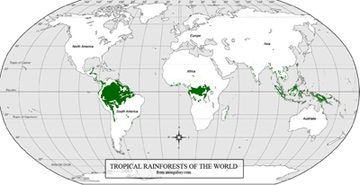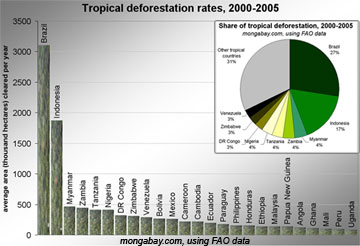U.S. climate policy could help save rainforests
U.S. climate policy could help save rainforests:
An interview with Jeff Horowitz,
Founding Partner of Avoided Deforestation Partners
Rhett Butler, mongabay.com
May 14, 2008
|
|
U.S. policy measures to fight global warming could help protect disappearing rainforests, says the founding partner of an “avoided deforestation” policy group.
In an interview with mongabay.com, Jeff Horowitz of the Berkeley-based Avoided Deforestation Partners argues that U.S. policy initiatives could serve as a catalyst for the emergence and growth of a carbon credits market for forest conservation.
REDD or Reducing Emissions from Deforestation and Degradation is a proposed policy mechanism that would compensate tropical countries for safeguarding their forests. Because deforestation accounts for around a fifth of global greenhouse gas emissions, efforts to reduce deforestation can help fight climate change. Forest protection also offers ancillary benefits like the preservation of ecosystem services, biodiversity, and a homeland for indigenous people.
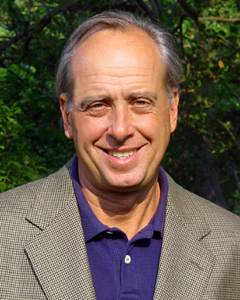 Jeff Horowitz |
While REDD was excluded from the Kyoto protocol, policymakers meeting in Bali last December signaled that forestry would play a role in future emissions mitigation schemes. The news was welcomed by a coalition of rainforest nations which had been lobbying for the concept and some environmentalists, who see it as a way to make forest conservation pay for itself. Rural populations would also stand to benefit from the initiative.
“The rational economic choice at the local level must be to keep the trees rather than burn them or chop them down,” Horowitz said. “Achieving this fundamental shift will require more than a top down REDD system. It will require all relevant parties at the local, regional, national and international levels to work together with a greater degree of cooperation than ever before. But, we are very optimistic because it ultimately is in all of the parties’ self interest to do so. In order for everyone to get their fair share they all have to perform. That is the beauty of using a market system.”
REDD: a policy-driven market
Horowitz says that while there is a lot of enthusiasm for REDD, there are still a number of hurdles to overcome. Because REDD will be a policy-driven market, getting the proper policy in place will be key to making the concept a reality.
“Policy is definitely the key. But it will either provide the catalyst for REDD or prevent REDD from being a meaningful part of the climate change solution,” Horowitz said. “We need to get the policy right to ensure REDD plays the role it should. Bali was a key moment for REDD. Now, the U.S. is playing the critical role.”
“Simply put, policy-driven markets require clear, long-term policy to attract capital at scale. REDD is meaningless unless we have scale.”
Despite the present lack of U.S. climate policy, Horowitz is hopeful that lawmakers will see the virtues of REDD for reducing greenhouse gas emissions.
“We are especially optimistic that in the near term the U.S. Congress will recognize the urgency of REDD and take the action that is necessary to prevent irreplaceable rainforests from continuing to be destroyed,” he said. “We hope we have that policy signal in place soon.”

|
Avoided Deforestation Partners recently held the first major public event in support of REDD legislation. Meeting in Washington D.C. on May 5th, attendees included business leaders, scientists, and Congressional staff members. Speakers included Wangari Maathai, recipient of the 2004 Nobel Peace Prize, Founder and President of The Green Belt Movement; Jim Rogers, CEO of Duke Energy; Jim Rogers, CEO of Duke Energy; Stephanie Meeks, Acting President of The Nature Conservancy; Russell Mittermeier, President of Conservation International; Stuart Eizenstat, former US Ambassador and Partner at Covington & Burling LLP; Kathleen Kennedy Townsend, Environmentalist and former Lieutenant Governor of Maryland; Fred Krupp, President of Environmental Defense Fund; Ken Newcombe, Managing Director, US Carbon Emissions Desk, Goldman Sachs; Thomas Lovejoy, President of The Heinz Center; and John Holdren, President and Director of The Woods Hole Research Center.
Speaking at the gathering, Horowitz said that U.S. leadership on REDD could spur global action on deforestation on climate.
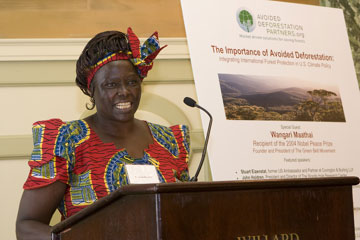 Wangari Maathai, recipient of the 2004 Nobel Peace Prize, Founder and President of The Green Belt Movement, at the Avoided Deforestation Partners meeting in Washington, D.C. on May 5, 2008. Photo by Erika Nortemann of The Nature Conservancy (TNC) |
“We have an opportunity to become not just a key player, but a global leader to do the work that the world is waiting for and desperately needs — without waiting for government funding or continuing to place an unfair burden on philanthropists and conservation groups to do all the heavy lifting,” he said.
“If we get this right, U.S. lawmakers have an extraordinary opportunity to lead the way and create climate policies that significantly reduce emissions from deforestation in developing countries. Such leadership could help make saving a tropical forest more valuable than its destruction, yielding substantial economic, social and environmental benefits at both the local and global levels.”
AN INTERVIEW WITH JEFF HOROWITZ
Mongabay: What inspired you to shift from a career as an architect to helping promote REDD as a U.S. policy response to climate change?
Jeff Horowitz: In addition to having had the privilege of directing large-scale urban planning projects in many countries, I was the founding director of Urbanists International, a non-profit organization that provided pro bono urban planning and economic development services to developing countries. Through my experiences with UI, I was engaged in shaping land use planning policies on a national level with many government and private sector counterparts. In all cases our exchanges were a full collaboration, the conversations respectful and included the full range of stakeholders. The results were quite successful.
As a consequence of my international policy background, two years ago, I was asked to help with the start-up of a U.S. based carbon-forestry company. Early on, while working on a major Avoided Deforestation project, it did not take long to discover the lack of rules and, more alarmingly, the absence of incentives for private sector involvement. Given my background as an NGO director and deep personal concern about the need for solutions to climate change, I left the company and teamed up with a committed group of kindred spirits to start Avoided Deforestation Partners. Beginning with co-founder Dr Charlotte Streck of Climate Focus, our team includes some of the best policy thinkers and representatives from a broad spectrum for individuals and organizations, both for and non-profit. Now, a year or more later, we have an exploding network of supporters and experts, all of whom care deeply about the urgent need for practical, effective market driven solutions for international forest conservation.
Mongabay: What needs to be done to improve the market for REDD? Does it all boil down to policy? If so, what is being done to drive policymakers toward being more receptive to REDD?
Jeff Horowitz: Policy is definitely the key. But it will either provide the catalyst for REDD or prevent REDD from being a meaningful part of the climate change solution. We need to get the policy right to ensure REDD plays the role it should. Bali was a key moment for REDD. Now, the U.S. is playing the critical role. As both forest preservation advocates and large GHG emitters descend on Washington, the key message of the virtues of including REDD in the U.S. scheme from both groups is beginning to take hold. The challenges now are to ensure REDD stays on the table and to increase its role proportionate to deforestation’s contribution to the climate crisis.
Mongabay: Are you optimistic that U.S. policymakers will eventually support REDD as an effective mechanism for fighting climate change?
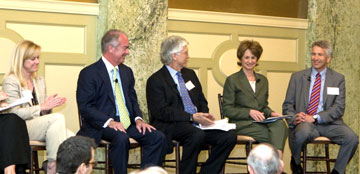 Stephanie Meeks, Jim Rogers, Russell Mittermeier, Kathleen Kennedy Townsend, and Fred Krupp. Photo by Erika Nortemann of The Nature Conservancy (TNC) |
Jeff Horowitz: Yes. But there is still far more convincing that needs to be done, and we need to make REDD a bigger piece of the legislative solution. Over time, the U.S. Congress will come to the realization that REDD has many friends, but many on the Hill still do not fully understand this complex issue. AD Partners is committed to this education battle. Tremendous potential support is out there, for example from groups like CARE international, Oxfam and other large poverty groups. While the major US-based conservation organizations have lead the way there is the potential for many new partners when it comes to pressing the importance of this issue. Support has really been growing exponentially as groups and individuals learn about the multiple benefits of REDD.
Mongabay: Given that REDD credits are limited to voluntary markets, they trade at a discount to other credits at present. Do you think we’ll see a premium for REDD credits? In other words, a premium market for carbon credits linked to biodiversity conservation and other ecosystem services or is forest carbon just another commodity?
Jeff Horowitz:
If you compare REDD credits to EUAs, there is a significant price difference, but if you compare forestry related VERs against tCERs under Kyoto, the VERs command a higher price. The problem is that the wrong policy can do more harm than good. By creating a temporary credit for forestry, the COP under the Kyoto Protocol created a devalued asset with the forestry credit and it has been a failure. The key going forward is to learn from that mistake and properly value the REDD (and other forestry) credits in the policy design. REDD may be deserving of a premium for non-carbon reasons, but it should at least be on a level playing field with other GHG credits in respect of carbon.
Mongabay: Do you see REDD clearing a path for other ecosystem payments like water?
Jeff Horowitz:
REDD does not always lead the way on ecosystem payments. There are ongoing initiatives and early market activities around the other environmental markets, such as wetlands mitigation banking, water quality and endangered species habitat. Whichever market leads, we hope there is a new economic paradigm that finally stops treating the services provided by our natural systems as “externalities” or valueless. That being said, in my view, REDD should serve as a broad umbrella for ecosystem services. The carbon stored in trees is clearly only one part of the overall ecosystem.
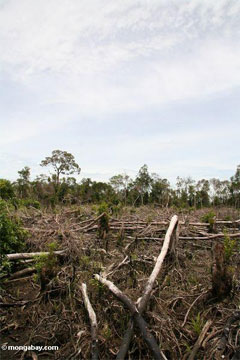 Slash-and-burn agriculture in Kalimantan on the island of Borneo. Photo by R. Butler. |
Mongabay: Are you hopeful that REDD can be implemented on the kind of scale that would be needed to save tropical forests? Will REDD alone offer the kind of returns that will make it viable relative to other forms of land use?
Jeff Horowitz:
Yes, very much so. Markets can make a profound difference. Just the word or rumor of a market has an immediate effect. What we need to do is harness the power of the market in a different direction. The rational economic choice at the local level must be to keep the trees rather than burn them or chop them down. Achieving this fundamental shift will require more than a top down REDD system. It will require all relevant parties at the local, regional, national and international levels to work together with a greater degree of cooperation than ever before. But, we are very optimistic because it ultimately is in all of the parties’ self interest to do so. In order for everyone to get their fair share they all have to perform. That is the beauty of using a market system.
Mongabay: REDD discussions can be quite contentious. What are some of the hot button issues?
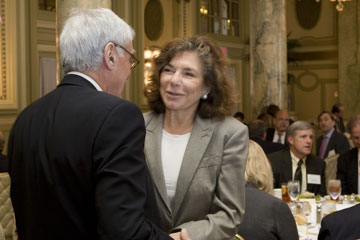 Frank Loy and Teresa Heinz at the Avoided Deforestation Partners meeting in Washington, D.C. on May 5, 2008. Photo by Erika Nortemann of The Nature Conservancy (TNC) |
Jeff Horowitz:
There really are reasonable and creative solutions to all the “hot button issues” at this moment in time. Sadly, many of these issues continue to create a distraction from the real need; moving on REDD now! I have tremendous respect for the very bright and caring people who are nervous about the variables involved, but inadvertently or not, rainforests are destroyed while the details or ramifications are being highlighted, we really need to get this program started, understanding that no policy in any realm is ever perfect. There is always room for course corrections if blatant flaws are revealed after projects have been up and running. While we sweat the details, every 10 minutes another 1000 acres of tropical rainforest is lost.
Mongabay: Have you seen much investor interest in REDD or are carbon buyers still frightened off by what is essentially a policy-driven market?
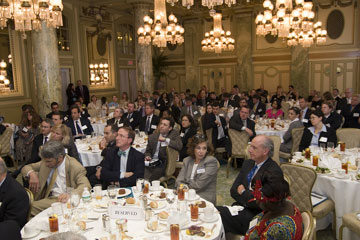 AD Parthers lunch meeting in Washington, D.C. on May 5, 2008. Photo by Erika Nortemann of The Nature Conservancy (TNC) |
Jeff Horowitz:
We see significant investor interest and desire to place investments, but we also see rational money managers waiting until there is more clarity on the rules of the game. Simply put, policy-driven markets require clear, long-term policy to attract capital at scale. REDD is meaningless unless we have scale. We hope we have that policy signal in place soon. We are especially optimistic that in the near term the U.S. Congress will recognize the urgency of REDD and take the action that is necessary to prevent irreplaceable rainforests from continuing to be destroyed. One very important, but perhaps under-appreciated benefit of saving tropical forests through economically valuing the services they provide, is that such economic assistance towards preservation would help sustain the peoples that rely upon the rainforests for their livelihoods and sustenance.
Mongabay: How can the general public help your efforts?
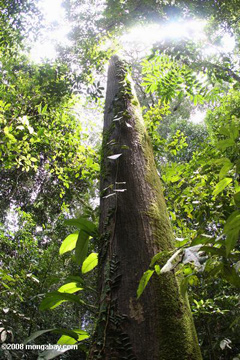
|
Jeff Horowitz:
From an American’s perspective, it is shocking to me that most people in the U.S. and are totally unaware of the magnitude and incredible seriousness of this issue. Very few really know that REDD represents a larger problem than all of the CO2 from the entire transportation sector. Very few people really know that tropical deforestation is between 15-25% of the climate change problem. When you think of images of global warming most people think of melting glaciers and they say to themselves, well there is not a lot I can do. This is not the case for burning tropical rainforests (and I do wish our media would have at least a few more of those images on TV or youtube). At this moment in time Congress is deliberating powerful legislation that does offer a viable solution to reducing international tropical deforestation. Everyone in the U.S. can get involved by writing to his or her congressional representative. They can demand that their legislators make the effort to understand it more fully and support climate change legislation that includes international avoided deforestation provisions. Here in the U.S. we have an opportunity to take the lead on the most important climate change solution of our time and it that does not require waiting for new technology to be developed.
